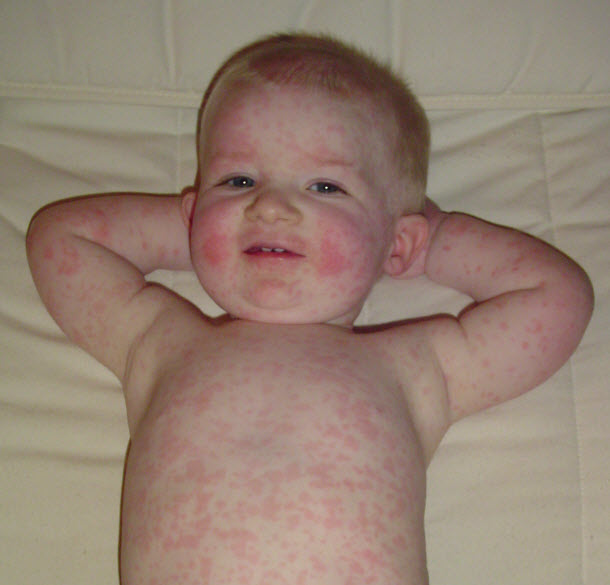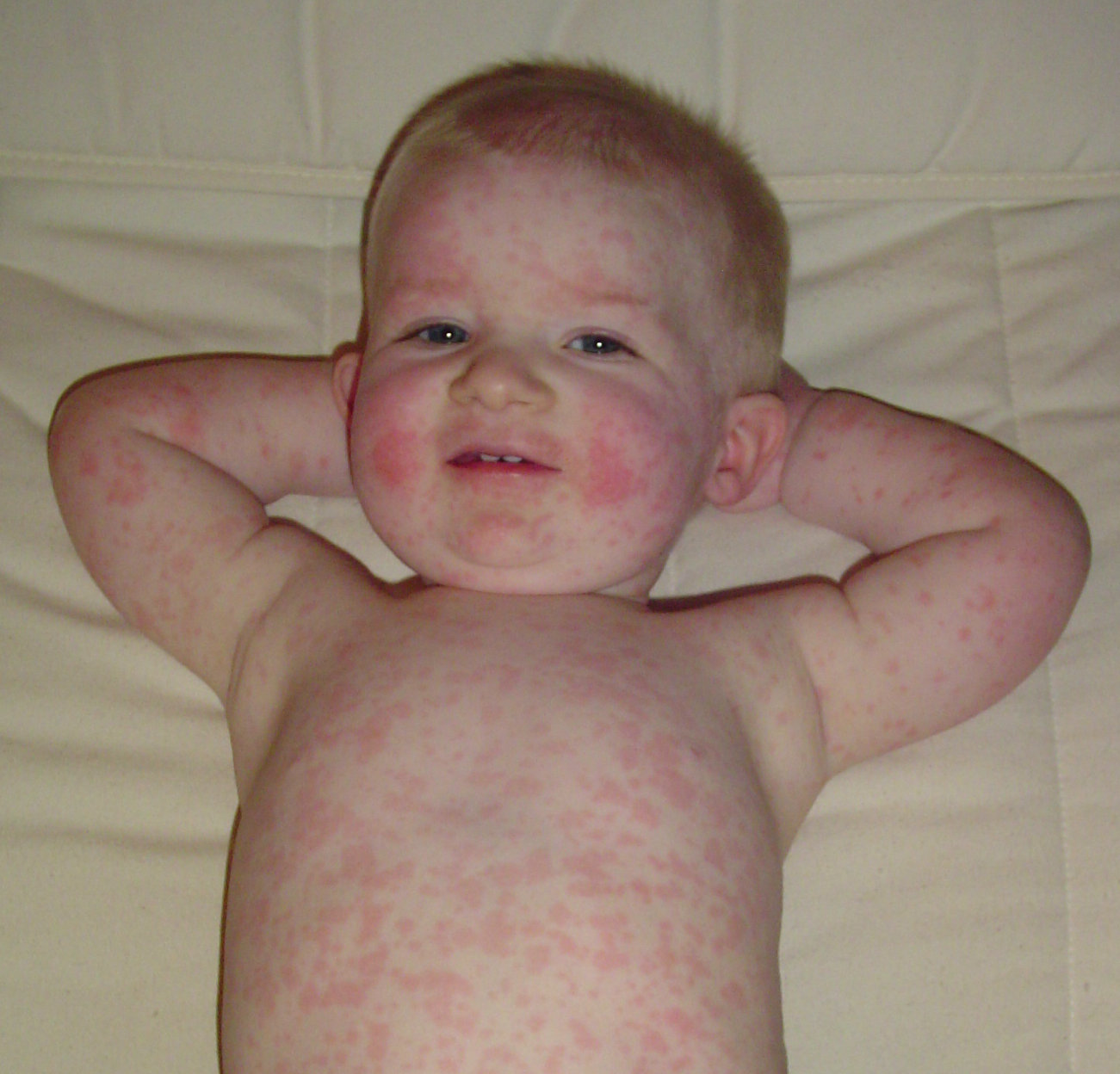Fifth disease: causes, symptoms, diagnosis and treatment
Fifth disease is a mild illness also known as erythema infectiosum. This disease is of viral origin and is more common in children than in adults. This disease is also known by several conventional names like slap cheek, slap face, slapped face or slapped cheek syndrome. In Hungary this illness is called butterfly pox. In Japan this disease is known as apple sickness.
Causes of fifth disease
As mentioned before, this disease is of viral origin. The virus responsible for this disease is Parvovirus B19. This virus spreads from one individual to another through respiratory secretions like saliva, nasal mucus and sputum.
The disease is more contagious as compared to other disease associated with redness and rash. For instance in case of Measles, the affected individual can spread the virus when he/she gets the rash. But in this disease the affected person remains infectious for long before and after the disease. The virus can also spread from one individual to another through body fluids other than nasal and oral secretions. Blood transfusion is an important way through which the virus infects a healthy child.
The virus responsible for disease follows a vertical transmission i.e. the virus can pass the placenta and can infect a fetus during pregnancy.
Signs and symptoms of fifth disease
The signs and symptoms of this disease appear in a sequential manner i.e. the disease progresses from mild to moderate and then sever form.
Following are some important symptoms of this disease in children:
- The disease starts with the appearance of mild headache and fever. Later the child starts to show cold like symptoms i.e. running nose, running eyes, lethargy and malaise. These symptoms last for a few days and resolve on their own.
- This is followed by the appearance of rash on the body. The rash is bright red and mostly appears on the face, especially on the cheeks. When this symptom appears, it is quite clear that the child has got fifth disease. The rash can then spread to other parts of the face including the bridge of nose and area around the mouth.
- In the later stages of the disease, the rash doesn’t remain confined to the cheeks. The rash extensively spreads to other parts of body including upper arms, torso and legs. The rash is itchy and lasts for several weeks.
Teenagers and adults may present with following signs and symptoms:
- The patient may develop self limiting arthritis characterized by pain and swelling in the joint.
- Difficulty in walking and bending of knees, ankles, shoulders and ankles.

Source: Andrew Kerr / Wikimedia Commons
Treatment for fifth disease
Fifth disease, as mentioned earlier, is a self limiting condition i.e. the disease goes away on its own. The symptoms usually go away if the person is healthy, gets adequate rest and proper nutrition. As far as the treatment is concerned, it is mostly symptomatic. Anti-pyretics can be given to cure fever and analgesics can be given to ease join pain. Addressing the itching through medicines is also included in this approach.
The only effective treatment is prevention and following steps can be taken to prevent the spread of this disease:
- Wash your hands with soap and water.
- Cover your mouth and nose while you cough or sneeze. Try to wash your hands afterwards.
- If you get the infection, it is advisable that you don’t touch your eyes, nose or mouth.
- Avoid close contact with affected individuals.
- Timely isolation might be helpful in preventing the disease. For instance if a school going child gets this condition, he can take off from school for some days. This way the chances of spread to other children can be minimized.
- Take adequate rest and proper nutrition while you’re sick.
- Contact your healthcare provider for more knowledge about the disease, its treatment and prevention.
Exams and diagnosis of fifth disease
There are no specific tests or exams that could help in diagnosing this disease.
Two things help:
- The first thing that doctor asks would be how and when you got this illness. He will inquire if you’ve been in contact with an affected individual.
- The second step is physical examination. The slapped face appearance is so characteristic that no further examination is needed.
Prognosis of fifth disease
The prognosis of this disease is usually very good. The disease is mostly self limiting and the symptoms usually go away spontaneously. Symptomatic treatment with different drugs further speeds up the recovery process. Beside the use of medicines, conventional methods like adequate rest, proper sleep, proper diet and getting large quantities of fluids are useful and can significantly improve the therapeutic outcomes of the drugs used. However, there are some conditions in which this illness can cause life threatening complications; such conditions are mentioned in the next section.
Complications of fifth disease
As mentioned earlier, fifth disease is a self limiting condition and the symptoms usually go way with or without adequate treatment. Complications of this disease are extremely rare. However, there are certain vulnerable groups of people in which this minor ailment can prove to be havoc.
Such groups and associated complication are mentioned below:
- The first most vulnerable group is that of pregnant ladies. This group is perhaps at the greatest risk of developing serious complications for both mother and her child. As mentioned before, the virus can follow a vertical transmission. The virus moves across placenta and can cause the accumulation of fluid inside the fetus. This condition is called Hydropis fetalis. This condition is very serious as it can lead to spontaneous abortion in affected females.
- Another possible complication of this illness is increased breakdown of red blood cells leading to anemia. In severe cases it can lead to aplastic crisis and death (very rare). People that have some congenital anomaly associated with blood are more prone to develop this condition. Such group of people include people suffering from: Hemolytic anemias; Hereditary spherocytosis or Aplastic anemia.
- Joint pain and skin rash is a complication seen in patient with HIV or patients undergoing chemotherapy, since the immunity of such patients is suppressed.
| Written by: | Michal Vilímovský (EN) |
|---|---|
| Education: | Physician |
| Published: | March 27, 2014 at 2:14 AM |
| Next scheduled update: | March 27, 2016 at 3:14 AM |
Get more articles like this in your inbox
Sign up for our daily mail and get the best evidence based health, nutrition and beauty articles on the web.


Ache in left arm that you should not ignore
Alkaline water dangers: why you should not drink it
How to Avoid Sleepiness While Studying?
23 Foods That Increase Leptin Sensitivity
Low dopamine (e.g. dopamine deficiency): causes, symptoms, diagnosis and treatment options
Swollen taste buds: the ultimate guide to causes, symptoms and treatment
Thin endometrial lining: causes, symptoms, diagnosis and treatment
Pimples inside nose: the complete guide
Holes in tonsils: definition, symptoms, treatment and prevention
How to deal with an ingrown hair cyst
Allegra vs. Zyrtec vs. Claritin
Allergy to penicillin and alternative antibiotics
How to get rid of phlegm (excessive mucus) in throat? Detailed guide to medical and home remedies, symptoms and causes
What causes stomach ache after meals?
Liver blood test results explained